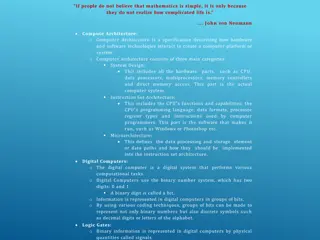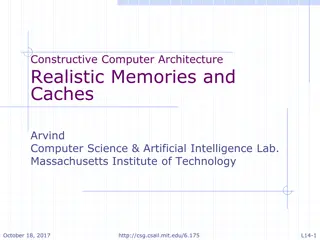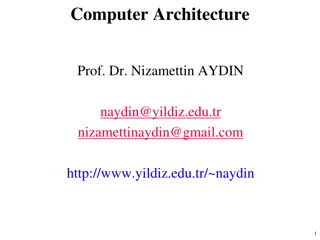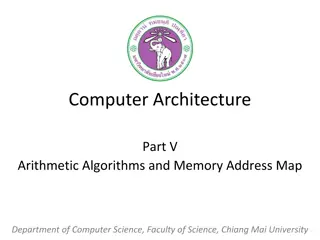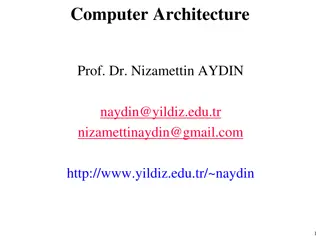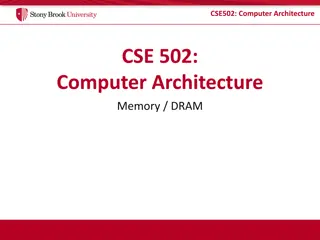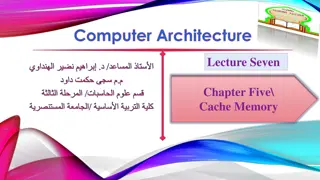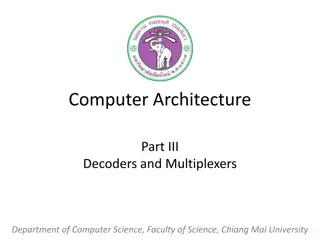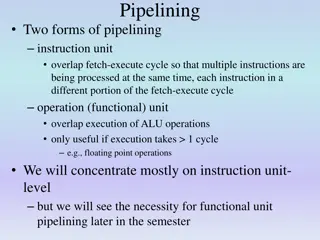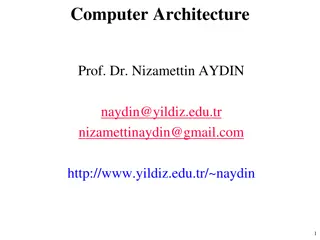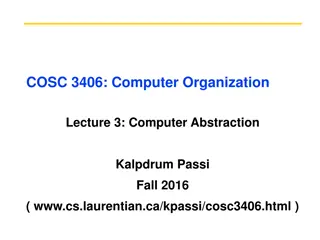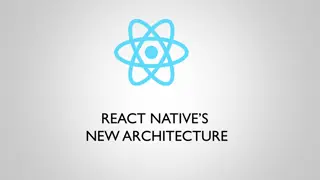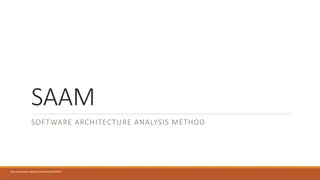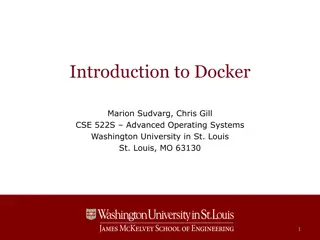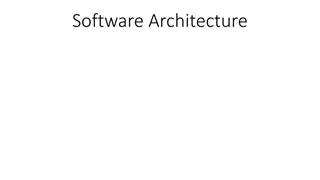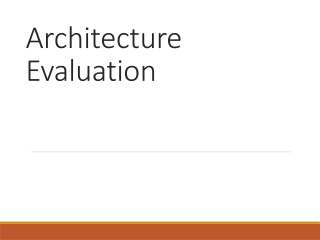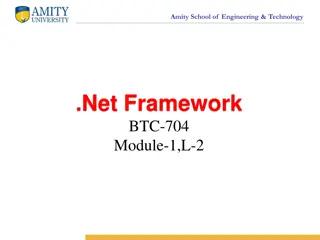Understanding Computer Architecture in CSE502
Exploring the intricate details of computer architecture in CSE502, covering concepts such as instruction commit, pipeline stages, program execution order, CPU state management during context switches, and implementation in the CPU. The focus is on the sequential part and the unified register file, with insights into branch mispredictions and their impact on processor state.
Download Presentation

Please find below an Image/Link to download the presentation.
The content on the website is provided AS IS for your information and personal use only. It may not be sold, licensed, or shared on other websites without obtaining consent from the author. Download presentation by click this link. If you encounter any issues during the download, it is possible that the publisher has removed the file from their server.
E N D
Presentation Transcript
CSE502: Computer Architecture CSE 502: Computer Architecture Instruction Commit
CSE502: Computer Architecture The End of the Road (um Pipe) Commit is typically the last stage of the pipeline Anything an insn. does at this point is irrevocable Only actions following sequential execution allowed E.g., wrong path instructions may not commit They do not exist in the sequential execution
CSE502: Computer Architecture Everything Should Appear In-Order ISA defines program execution in sequential order To the outside, CPU must appear to execute in order When is someone looking?
CSE502: Computer Architecture Looking at CPU State When OS swaps contexts OS saves the current program state (requires looking ) Allows restoring the state later When program has a fault (e.g., page fault) OS steps in and looks at the current CPU state
CSE502: Computer Architecture Implementation in the CPU ARF keeps state corresponding to committed insns. Commit from ROB happens in order ARF always contains some RF state of sequential execution Whoever wants to look should look in ARF What about insns. that executed out of order?
CSE502: Computer Architecture Only the Sequential Part Matterns LSQ Memory Memory ROB RS PC PC RF RF fPC PRF Sequential View of the Processor State of the Superscalar Out-of-Order Processor What if there s no ARF?
CSE502: Computer Architecture View of the Unified Register File If you need to see a register, you go through the aRAT first. sRAT PRF ARF aRAT
CSE502: Computer Architecture View of Branch Mispredictions Wrong-path instructions are flushed LSQ architected state has never been touched Memory ROB RS PC Fetch correct path instructions ARF fPC PRF Which can update the architected state when they commit Mispredicted Branch
CSE502: Computer Architecture Committing Instructions (1/2) Retire vs. Commit Sometimes people use this to mean the same thing Sometimes they mean different things Check the context! Insn. commitsby making effects visible (A)RF, Memory/$, PC
CSE502: Computer Architecture Committing Instructions (2/2) When an insn. executes, it modifies processor state Update a register Update memory Update the PC To make effects visible, core copies values Value from Physical Reg to Architected Reg Value from LSQ to memory/cache Value from ROB to Architected PC
CSE502: Computer Architecture Blocked Commit To commit N insns. per cycle, ROB needs N ports (in addition to ports for dispatch, issue, exec, and WB) Can t reuse ROB entries until all in block have committed. Can t commit across blocks. ROB ROB for four commits Four read ports inst 1 inst 2 inst 3 inst 4 inst 1 inst 2 inst 3 inst 4 One wide read port Reduces cost, lowers IPC due to constraints
CSE502: Computer Architecture Faults Divide-by-Zero, Overflow, Page-Fault All occur at a specific point in execution (precise) DBZ! Trap? (when?) DBZ! Trap Divide may have executed before other instructions due to OoO scheduling! (resume execution) CPU maintains appearance of sequential execution
CSE502: Computer Architecture Timing of DBZ Fault Need to hold on to your faults On a fault, flush the machine and switch to the kernel ROB Architected State RS Let earlier instructions commit The arch. state is the same as just before the divide executed in the sequential order Now, raise the DBZ fault and when you switch to the kernel, everything appears as it should Exec: DBZ Just make note of the fault, but don t do anything (yet)
CSE502: Computer Architecture Speculative Faults Faults might not be faults ROB Branch Mispredict (flush wrong-path) DBZ! The fault goes away Which is what we want, since in a sequential execution, the wrong-path divide would not have executed (and faulted) Buffer faults until commit to avoid speculative faults
CSE502: Computer Architecture Timing of TLB Miss Store must re-execute (or re-commit) Cannot leave the ROB TLB miss Trap Walk page-table, may find a page fault (resume execution) Re-execute store Store TLB miss can stall the core
CSE502: Computer Architecture Load Faults are Similar Load issues, misses in TLB When load is oldest, switch to kernel for page-table walk could be painful; there are lots of loads Modern processors use hardware page-table walkers OS loads a few registers with PT information (pointers) Simple logic fetches mapping info from memory Page-table format is specified by the ISA
CSE502: Computer Architecture Asynchronous Interrupts Some interrupts are not associated with insns. Timer interrupt I/O interrupt (disk, network, etc ) Low battery, UPS shutdown When the CPU notices doesn t matter (too much) Key Pressed Key Pressed Key Pressed
CSE502: Computer Architecture Two Options for Handling Async Interrupts Handle immediately Use current architected state and flush the pipeline Deferred Stop fetching, let processor drain, then switch to handler What if CPU takes a fault in the mean time? Which came first , the async. interrupt or the fault?
CSE502: Computer Architecture Store Retirement (1/2) Stores forward to later loads (for same address) Normally, LSQ provides this facility D$ D$ D$ st st st 33 17 17 ld ld ld ld At commit, store Updates cache After store has left the LSQ, the D$ can provide the correct value
CSE502: Computer Architecture Store Retirement (2/2) Can t free LSQ Store entry until write is done Enables forwarding until loads can get value from cache Have to re-check TLB when doing write TLB contents at Execute were speculative Store may stall commit for a long time If there s a cache miss If there s a TLB miss (with HW TLB walk) store All instructions may have successfully executed, but none can commit!
CSE502: Computer Architecture Writeback Buffer (1/2) Want to get stores out of the way quickly Even if store misses in cache, entering WB buffer counts as committing. D$ store ld Allows other insns. to commit. ld store WB buffer is part of the cache hierarchy. May need to provide values to later loads. WB Buffer Eventually, the cache update occurs, the WB buffer entry is emptied. Cache can now provide the correct value. Usually fast, but potential structural hazard
CSE502: Computer Architecture Writeback Buffer (2/2) Stores enter WB Buffer in program order Multiple stores can exist to same address Only the last store is visible No one can see this store anymore! Addr Value Load 42 next to write to cache 42 13 8 42 1234 -1 90901 5678 oldest Store 42 youngest Load 42
CSE502: Computer Architecture Write Combining Buffer (1/2) Augment WBB to combine writes together Addr Value Only one writeback Now instead of two Load 42 42 42 1234 5678 Store 42 Load 42 If Stores to same address, combine the writes
CSE502: Computer Architecture Write Combining Buffer (2/2) Can combine stores to same cache line One cache write can serve multiple original store instructions $-Line Addr Cache Line Data 5678 80 1234 Benefit: reduces cache traffic, reduces pressure on store buffers Aggressiveness of write-combining may be limited by memory ordering model Store 84 Writeback/combining buffer can be implemented in/integrated with the MSHRs Only certain memory regions may be write-combinable (e.g., USWC in x86)
CSE502: Computer Architecture Senior Store Queue Use STQ as WBB (not necessarily write combining) STQ Store Store STQ tail DL1 L2 STQ head STQ head STQ head Store Store Store Store Store Store Store Store While stores are completing, other accesses (loads, etc ) can continue getting the values from the senior STQ STQ tail New stores cannot allocate into Senior STQ entries until stores complete No WBB and no stall on Store commit
CSE502: Computer Architecture Retire Insn. retires by cleaning up all related state Besides updating architected state needs to deallocate resources ROB/LSQ entries Physical register colors of various sorts RAT checkpoints Most are FIFO s or Queues Alloc/dealloc is usually just inc/dec head/tail pointers Unified PRF requires a little more work Have to return old mapping to free list








